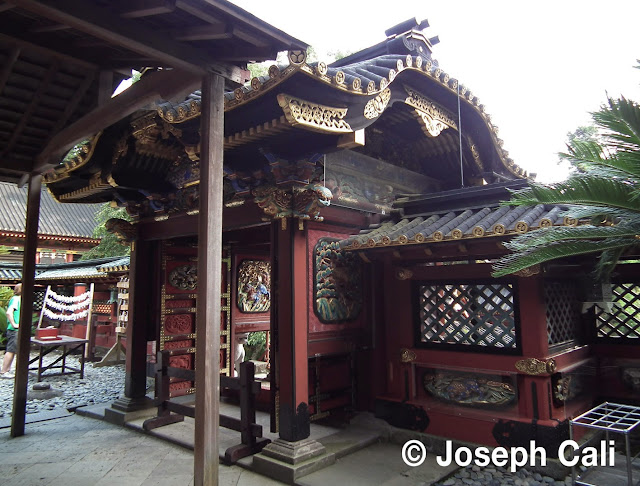Photo Tour of Kunozan Toshogu Jinja
In
Shinto Shrines: A Guide to the Sacred Sites of Japan's Ancient Religion,
my focus was on delivering as much information as possible about as
many shrines as possible. The original goal was 100 shrines but this
would have necessitated a massive book at a massive price (as well as an
irate publisher). Since I was unwilling to compromise the information
for each shrine, I compromised on the number of photos. In this blog
too, I have followed the style of the book and therefore images are
again minimal. But in the assumption that readers of the book and of
this blog might also be interested in seeing more of the places being
written about, I am presenting a series of Photo Tours. This one, the magnificent Kunozan Toshogu Jinja.
 |
| The zuijinmon of Kunozan Toshogu at the top of a lengthy staircase. |
Another of the splendid Toshogu shrines featured in the book this shrine should perhaps have been the first of these photo tours. After all, it is the first place in which the spirit as well as the physical remains of Tokugawa Ieyasu were interred. At that time the rights were conducted under the direction of the Yoshida family and their brand of Yuitsu Shinto (One-and-only Shinto).
 |
| The zuijin (guardian) on the right side of the entrance. His mouth is open in the classic "a" gesture, forming a pair with the closed-mouth figure ("un")
on the left side. These are the first and last letters of the Sanskrit
alphabet and symbolizes the beginning and end. The gesture is common to
Buddhist nio guardian figures at the entrance to temples, as well as the komainu
used at the entrance to Shinto shrines. These Shinto guardians are
usually sitting upon a lion skin and are armed with swords, bow and
arrows. |
 |
| While shrine visitors who are familiar with the typical stone komainu
might find this gold and blue version startling, I am told that it is
of a very old type. My first encounter with such was at the Kamigamo
shrine in Kyoto, where the coloration is silver and blue. The komainu here are located on the back side of the zuijinmon and sport the same open and closed mouth poses. |
However, this was not to be Ieyasu's final resting place. About one year after after his interment, the story goes that he was transferred to Nikko in Tochigi prefecture so that he could guard the country and his beloved Edo. He was supposed to have left a sort of last will and testament to this effect but it is also the case that the Tendai prelate Tenkai, who was a confidant of Ieyasu and of his grandson Iemitsu, was fighting to preserve the position of his sect after it was devastated by Oda Nobunaga. It is likely too that Iemitsu, who by all accounts revered his grandfather, was anxious to secure his own position and that of his clan by having Ieyasu elevated to the level of
kami, at the head of his own sect. He and Tenkai worked together to successfully create the cult of Toshogu Daimyojin.
 |
| Near the top of Mount Kuno, overlooking Suruga Bay, on the former sight
of one of his implacable enemies, stands the first shrine to Tokugawa
Ieyasu. The heiden connected to the honden behind is clearly visible in this photo of the splendidly detailed gongen-zukuri shrine. The photo shows the side gate. |
 |
| The entrance to the heiden showing the rich detailing especially above the tie-beams. The entrance and surrounding fence primarily in cinnabar red and the shrine primarily in black with polychrome and gold details. Notice the three-hollyhock leaf kamon of the Tokugawa on the saisenbako. |
|
 |
| The inside of the main entrance, a four-legged mukaikaramon (also called a karamon) with karahafu on all four sides. The side panels are carved in deep relief and the gate connects to the same type of sukashi-bei fence which we saw on the Ueno Toshogu shrine. |
 |
| A view toward the honden. |
 |
| A detail of the rich carving and polychroming above the nageshi. Of particular interest is the way in which one corner has been left un-renovated (the pale color area). This was done to preserve an example of the older decoration in order to assist future renovators with an original reference point. The shrine was completely renovated several years ago. |
 |
| As with Nikko Toshogu, behind the shrine is located the crypt of Ieyasu. Upon questioning a very kind negi of the shrine, I was told that some remnant of the body was left behind when it was transferred to Nikko. Apparently, the body was originally interred in a sitting position inside the stupa-shaped crypt. |
 |
| The climb up Mount Kuno is more than only the most hardy can endure. The recommended route is to take the cable car to the top and walk back down. The photo shows one small section of the serpentine stairway that winds up the side of the mountain, along with a glimpse of the bay. Even the trip down was grueling and though it was quite difficult in the summer heat, I wouldn't want to attempt it in a strong wind! There are only several buses per day from the train station to the lift so a taxi may be needed to get you that far. |










No comments:
Post a Comment